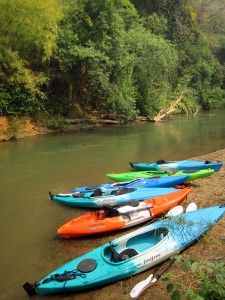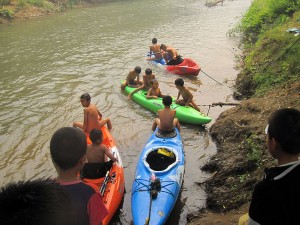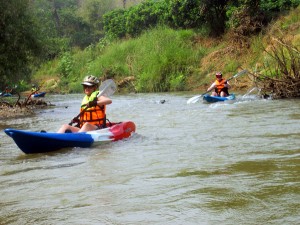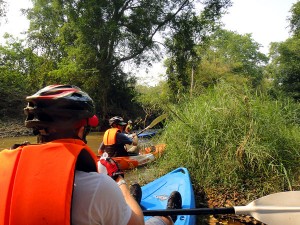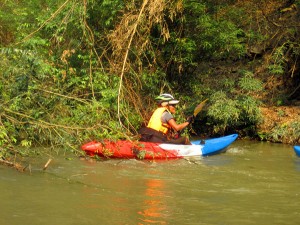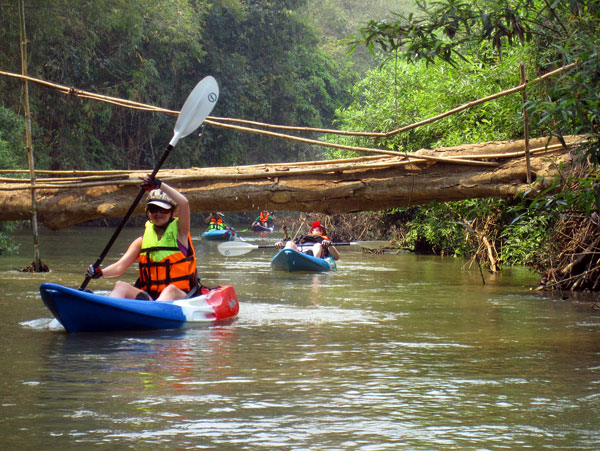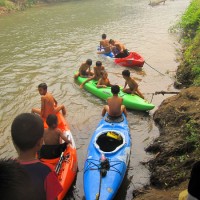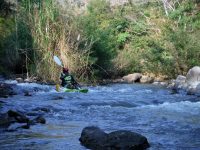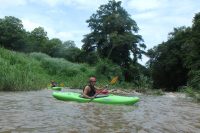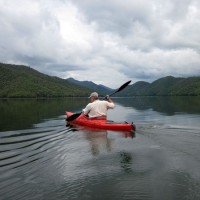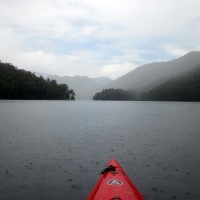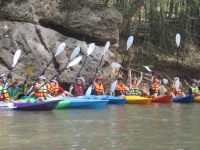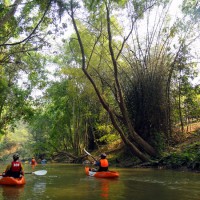
Chiang Mai Kayaking Class 1 -2 River basics and event briefing
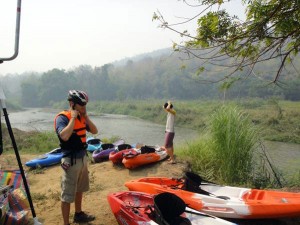
Here in Northern Thailand we are blessed with the perfect weather conditions to enjoy kayaking all year round. Hypothermia never comes in to play , the cool waters actually ad to the pleasant experience. While whitewater class 3-5 is only available during the cool and rainy season , leisure kayaking and jungle exploration is doable all year on various section of the rivers , we do not share the same over crowded waters as the rafting companies have to . We enjoy an exploratory approach to our kayaking expeditions. Although we do provide a set program we always are taking weather and water conditions into consideration and are flexible enough to pick the best river sections for the day after meeting the groups. Guides are at home on the rivers and are happy to assist you to ensure a safe passage down the river.
You should be an average swimmer. Participants planning kayaking on rivers should have some upper body strength and have some sport back ground such as tennis ,squash, swimming, fencing (haha) anything that requires upper body strength . In difference to rafting you are the captain of your own boat and are solely directing it down the river. Sudden spurts of aggressive paddling are to be expected at times . The good news is though , if you do mess up the consequences are mild . If you want plenty of time to make your moves we have the perfect river sections for you such as Kayak D (Mae Ngat valley), here the water runs lazily through the Valley into the Mae Taeng Forest Reserve , perfect for family fun. Kayak A and E for example are a bit more challenging.
For very young children (under 9) we usually recommend paddling the lake and River Trip D with and adult in a double Kayaks.

On Jungle Trip rivers such as Trip E, A we prefer single kayaks (vs Doubles), the more challenging the waters the smaller and more maneuverable the boats should be. For beginners in challenging river sections a maneuverable Sit on Top Kayak with backrest is the best bet. Wider currents with less ‘obstacles’, such as Trip D, Touring kayaks with large cockpits are provided. Advanced kayakers or kayakers that are prepared to do learn the “WET Exit “can be provided with White Water kayaks sit ins , usually on Kayak A or E. On multiday trips we use slightly longer White Water Touring kayaks so we have the forward speed but still have the maneuverability we need, such as the Jackson Karma RG

Karma Rg by Jackson Kayaks
Bring your friends
Our kayaking trips take place about 1 hrs driving of Chiang mai. Bring an extra set of clothes for the ride back .You should wear shorts or swimsuit, t-shirt or a lycra when on your kayak. Wear a hat, sunglasses, river shoes (sneakers ok, or river sandals that don’t come off) Bring sunscreen and repellent. Should you have none of the above , we are ready to equip you at our shop before departure.
Drinking water and Lunch is provided , bring only a water proof camera if you can. We have water proof cameras available. We sell cheap water proof phone bags .We provide: Helmets, life jackets, gloves and shoes .
 Before we head into the water a safety briefing and basic instructions (reminders for some) are given at the shop and launching site :
Before we head into the water a safety briefing and basic instructions (reminders for some) are given at the shop and launching site :
At the shop we touch on :
Paddle strokes
River currents , Eddies
Eddy out and Peel Out maneuvers
How to maneuver sharp turns
How to balance well on your boat and how currents effect your stability .
What to do when you become a swimmer
River communication such as Paddle signals
we suit you up , make sure your life jackets and helmets fit, provide you with shoes if needed
Here are some basics that are useful :
How to get into the boat
( turn your back to the boat and put you behind in first and then swing your legs in ) Avoid stepping into your boat and always hold on to your paddle throughout the process.
Body posture “LEAN FORWARD”
When putting maximum power into your strokes you should be sitting upright pushing your tail bone into the back rest while firmly pushing your heals into the foot rests, leaning slightly forward.
How to maneuver your boat :
Turning your boat with a forward sweep stroke
When planning to use your paddle stroke to turn your boat , the blade is put far away from the side of the boat to get better leverage.
Now we sweep the paddle from the front to the back . Paddle on the left , you turn right , direct command from the coach : “forward left !”
Paddle on the right, you turn left , direct command from the coach : “ forward right !”
Back stroke
The back stroke is used to pivot the nose of your boat into the desired new direction and is usually followed up with a forward stroke .
Back Paddle on your right, you pivot right , direct command from coach : “back right !”
Back Paddle on your left you pivot left , direct command from coach : “ back left !”.
 (before we get going)
(before we get going)
-
Enter the river (pointing your boat upstream)
- 360 degree turns . Alternating Back stroke on one side and forward stroke on the other side will accomplish this.
- “Eddy out !” is a direct command from coach asking to come to a stop. When completed you are facing upriver in a light opposite current zone (eddy) which are formed downstream of a rock, island or anything protruding into the main current . this maneuver is accomplished by making a U -Turn into such an eddy.
- “Eddy out left !”, is directed to an eddy on the left shore .
- “Eddy out right !”, is directed to an eddy on the right shore.
- A U-Turn, when completed facing upstream, is an effective way if you as long as you keep paddling against the current, to slow down or stop yourself from drifting downstream when there is no eddy.

Tilt your boat away from any new current prevents the current to hit the deck of the boat possibly flipping it.
Ferry across the river , paddling across the river current , you must point upstream in an angle towards the desired side that takes the push of the current in consideration . The stronger the current the steeper the angle. Look where you want to go, not where the boat is pointing, and adjust the angle as you drift across to get you there .
7. Drifting sideways (perpendicular to the current) is practiced because a lot of times we want drift into a turn already pointing in the new direction of the turn giving us valuable time to exit the turn .
 You become a swimmer 🙂
You become a swimmer 🙂
Hold on to your paddle (if you can), lay on your back and drift with your feet pointing down stream (so you can push off ) . You do not need to hold onto your boat. We will take care of your boat. Your goal is to drift and find the next eddy , turn over and swim in . Listen to coaches instructions to help you find the eddy. We will then reunite you with your boat. Other kayakers are ask to please eddy out immediately as soon as we have a swimmer and wait tor the peel out command, the all clear .
How to get back into your boat in deep water
Flip the boat back over, if it is self-bailing. Hold your paddle at the opposite side of the boat parallel to the edge, pull yourself across holding the opposite edge, until you lay across the center of the boat , then flip your body over and drop you behind into the seat and swing your legs in. When needed , mostly on open waters, you can climb over the bow of the guides boat and slide into your boat. The guide may also assist by pushing the boat with the bow to shore or /and pulling the swimmer holding on to the tail of the boat . The rest of the group unless assisting, eddy out and wait till the rescue is completed . 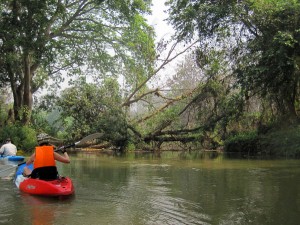
We do some river maintenance … this one though has to wait for now.
When approaching a difficult passage do it slowly so you can check out the situation . Watching the person in front of you, giving them plenty of space, helps analyze your plan of action. On some river sections the overhanging trees make the trip more interesting and “precision kayaking” comes to play. Some of the fallen trees or overhanging bushes become an obstacle or ‘strainer’, difficult to pass strainers are pointed out by the guides and you can prepare yourself. When paddling through overhanging trees or low bamboo etc. keep your head low and lean forward to protecting your neck and face, you can also use your paddle to block oncoming small branches and bamboo. Do not attempt to hold on to a passing branch, it will pull you sideways and you will flip over. Some narrow passages pointing the paddle forward makes it easier to get through, but be ready to control your boat as soon as you get clear and you’ll need the paddle back firm in your hands.
 A guide enters the water first and patrols the entry line and keeps everyone upstream doing their first 360 Degree turns to get used to the boat. We look at body posture and blade entry . When all is good we are on our way.
A guide enters the water first and patrols the entry line and keeps everyone upstream doing their first 360 Degree turns to get used to the boat. We look at body posture and blade entry . When all is good we are on our way.
1st task is to practice the Eddy Out maneuver the most important safety measure you have in the river . to stop . We practice drifting sideways and backwards downstream so you can fine tune your back and forward strokes . During the training phase we remind the paddler of their body posture and coach with direct commands on the paddle stroke . This phase is usually over in 30 minutes. The rest of the trip we assist where needed.
Safe River navigation in a group :
Usually its single file behind the lead guide, use the kayaker in front of you as reference but be sure when you enter difficult rapids , sharp turns etc. to keep distance to avoid a pile up. On difficult turns etc. a guide will be facing you as you enter the task, ready to assist you if needed,
From time to time the guide will ask the group to Eddy Out , so we can navigate 1 at a time through a particular sensitive area such around a strainer. You then will be signaled to Peel Out when we are ready for you.
The lead guide will call out the favorable side (go left, go right) of the river to paddle on, when required, this gives you heads up if there is a hazard coming up. We eddy out periodically just to stop, re group, smell the roses and drink water .
We take your safety seriously ,
most importantly enjoy yourself , relax on the easy parts, admiring the astonishing beauty of Northern Thailand’s river scenery.
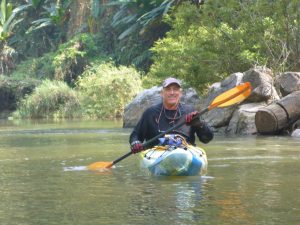
Happy Trails and to see on the water…
contact me anytime for questions, Aidan (Director)
src=”http://chiangmaikayaking.com/wp-content/uploads/2018/11/kayak-Certificate-Albert.jpg” alt=”” width=”507″ height=”380″ />


